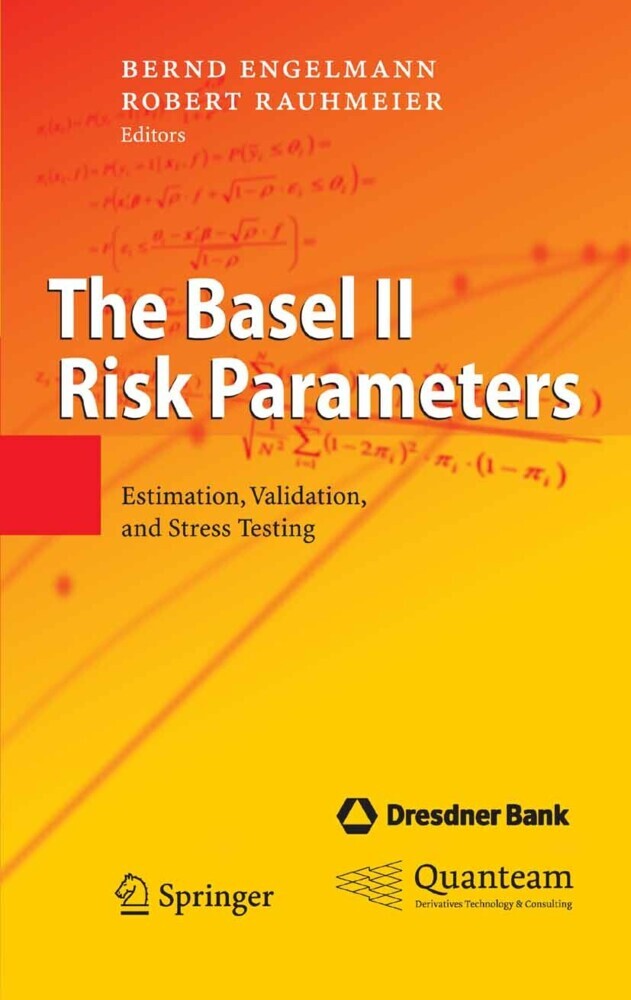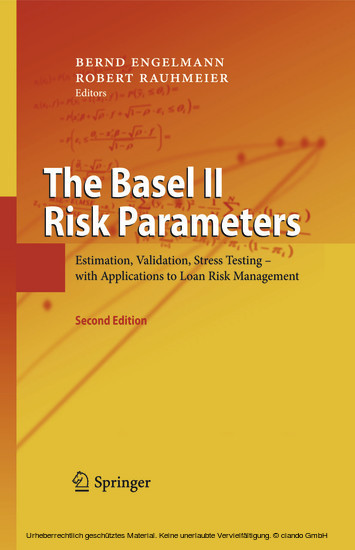The Basel II Risk Parameters
Estimation, Validation, and Stress Testing
A critical problem in the practice of banking risk assessment is the estimation and validation of the Basel II risk parameters PD (default probability), LGD (loss given default), and EAD (exposure at default). This book presents the state-of-the-art in designing and validating rating systems and default probability estimations, and outlines techniques to estimate LGD and EAD. Also included is a chapter on stress testing of the Basel II risk parameters.
1;Preface;5 2;Contents;9 3;I. Statistical Methods to Develop Rating Models;16 3.1;1. Introduction;16 3.2;2. Statistical Methods for Risk Classification;16 3.3;3. Regression Analysis;17 3.4;4. Discriminant Analysis;18 3.5;5. Logit and Probit Models;19 3.6;6. Panel Models;22 3.7;7. Hazard Models;23 3.8;8. Neural Networks;24 3.9;9. Decision Trees;25 3.10;10. Statistical Models and Basel II;26 3.11;References;27 4;II. Estimation of a Rating Model for Corporate Exposures;28 4.1;1. Introduction;28 4.2;2. Model Selection;28 4.3;3. The Data Set;29 4.4;4. Data Processing;30 4.4.1;4.1. Data Cleaning;30 4.4.2;4.2. Calculation of Financial Ratios;31 4.4.3;4.3. Test of Linearity Assumption;32 4.5;5. Model Building;34 4.5.1;5.1. Pre-selection of Input Ratios;34 4.5.2;5.2. Derivation of the Final Default Prediction Model;36 4.5.3;5.3. Model Validation;37 4.6;6. Conclusions;39 4.7;References;39 5;III. Scoring Models for Retail Exposures;40 5.1;1. Introduction;40 5.2;2. The Concept of Scoring;41 5.2.1;2.1. What is Scoring?;41 5.2.2;2.2. Classing and Recoding;42 5.2.3;2.3. Different Scoring Models;44 5.3;3. Scoring and the IRBA Minimum Requirements;45 5.3.1;3.1. Rating System Design;45 5.3.2;3.2. Rating Dimensions;45 5.3.3;3.3. Risk Drivers;46 5.3.4;3.4. Risk Quantification;46 5.3.5;3.5. Special Requirements for Scoring Models;47 5.4;4. Methods for Estimating Scoring Models;47 5.5;5. Summary;51 5.6;References;52 6;IV. The Shadow Rating Approach - Experience from Banking Practice;54 6.1;1. Introduction;54 6.2;2. Calibration of External Ratings;57 6.2.1;2.1. Introduction;57 6.2.2;2.2. External Rating Agencies and Rating Types;58 6.2.3;2.3. Definitions of the Default Event and Default Rates;59 6.2.4;2.4. Sample for PD Estimation;60 6.2.5;2.5. PD Estimation Techniques;61 6.2.6;2.6. Adjustments;62 6.2.7;2.7. Point-in-Time Adaptation;63 6.3;3. Sample Construction for the SRA Model;65 6.3.1;3.1. Introduction;65 6.3.2;3.2. Sample Types;66 6.3.3;3.3. External PDs and Default Indicator;69 6.3.4;3.4. Weighting Observations;71 6.3.5;3.5. Correlated Observations;71 6.4;4. Univariate Risk Factor Analysis;72 6.4.1;4.1. Introduction;72 6.4.2;4.2. Discriminatory Power;73 6.4.3;4.3. Transformation;74 6.4.4;4.4. Representativeness;77 6.4.5;4.5. Missing Values;78 6.4.6;4.6. Summary;80 6.5;5. Multi-factor Model and Validation;81 6.5.1;5.1. Introduction;81 6.5.2;5.2. Model Selection;81 6.5.3;5.3. Model Assumptions;82 6.5.4;5.4. Measuring Influence;85 6.5.5;5.5. Manual Adjustments and Calibration;87 6.5.6;5.6. Two-step Regression;88 6.5.7;5.7. Corporate Groups and Sovereign Support;88 6.5.8;5.8. Validation;89 6.6;6. Conclusions;90 6.7;References;91 7;V. Estimating Probabilities of Default for Low Default Portfolios;94 7.1;1. Introduction;94 7.2;2. Example: No Defaults, Assumption of Independence;96 7.3;3. Example: Few Defaults, Assumption of Independence;98 7.4;4. Example: Correlated Default Events;101 7.5;5. Potential Extension: Calibration by Scaling Factors;104 7.6;6. Potential Extension: The Multi-period case;107 7.7;7. Potential Applications;112 7.8;8. Open Issues;112 7.9;9. Conclusions;113 7.10;References;114 7.11;Appendix A;115 7.12;Appendix B;117 8;VI. A Multi-Factor Approach for Systematic Default and Recovery Risk1;120 8.1;1. Modelling Default and Recovery Risk;120 8.2;2. Model and Estimation;121 8.2.1;2.1. The Model for the Default Process;121 8.2.2;2.2. The Model for the Recovery;122 8.2.3;2.3. A Multi-Factor Model Extension;123 8.2.4;2.4. Model Estimation;125 8.3;3. Data and Results;126 8.3.1;3.1. The Data;126 8.3.2;3.2. Estimation Results;129 8.4;4. Implications for Economic and Regulatory Capital;133 8.5;5. Discussion;137 8.6;References;138 8.7;Appendix: Results of Monte-Carlo Simulations;139 9;VII. Modelling Loss Given Default: A "Point in Time"- Approach;142 9.1;1. Introduction;142 9.2;2. Statistical Modelling;144 9.3;3. Empirical Analysis;146 9.3.1;3.1. The Data;146 9.3.2;3.2. Results;149 9.4;4. Conclusions;153 9.5;References;154 9.6;Appendix: Macro
Engelmann, Bernd
Engelmann, Bernd
| ISBN | 9783540330875 |
|---|---|
| Artikelnummer | 9783540330875 |
| Medientyp | E-Book - PDF |
| Auflage | 2. Aufl. |
| Copyrightjahr | 2006 |
| Verlag | Springer-Verlag |
| Umfang | 376 Seiten |
| Sprache | Englisch |
| Kopierschutz | Digitales Wasserzeichen |











